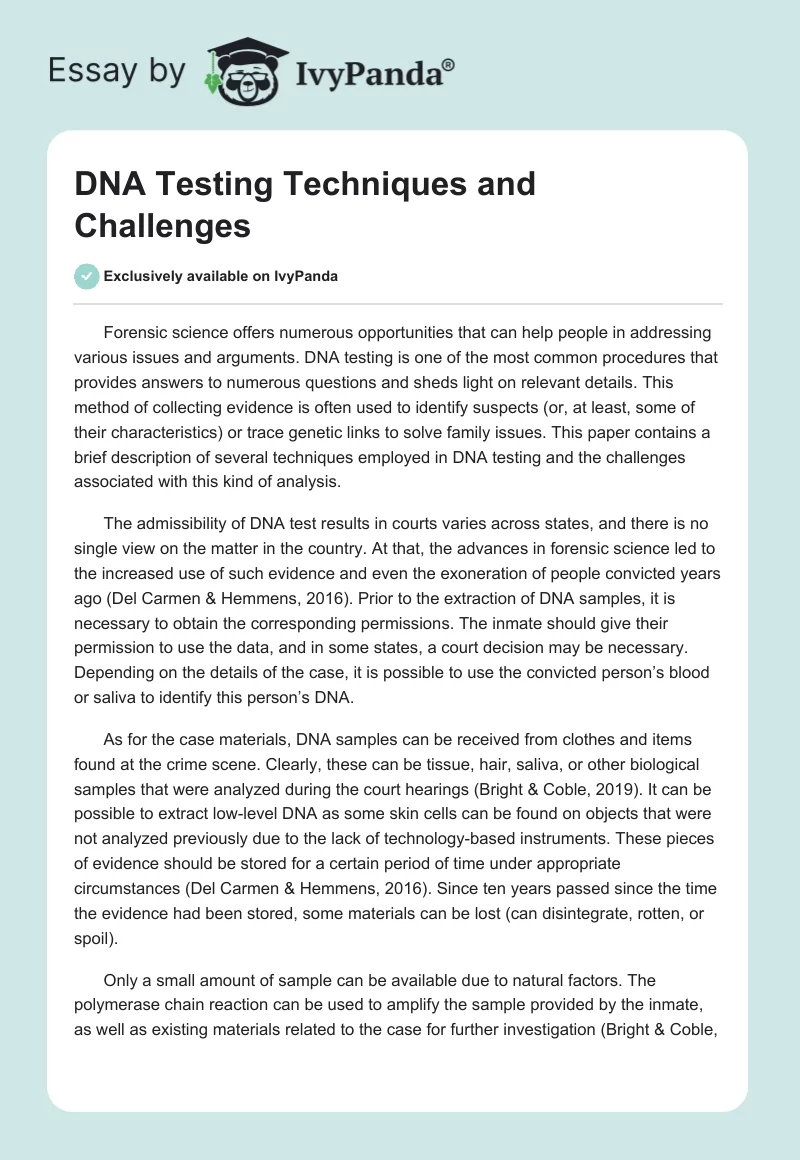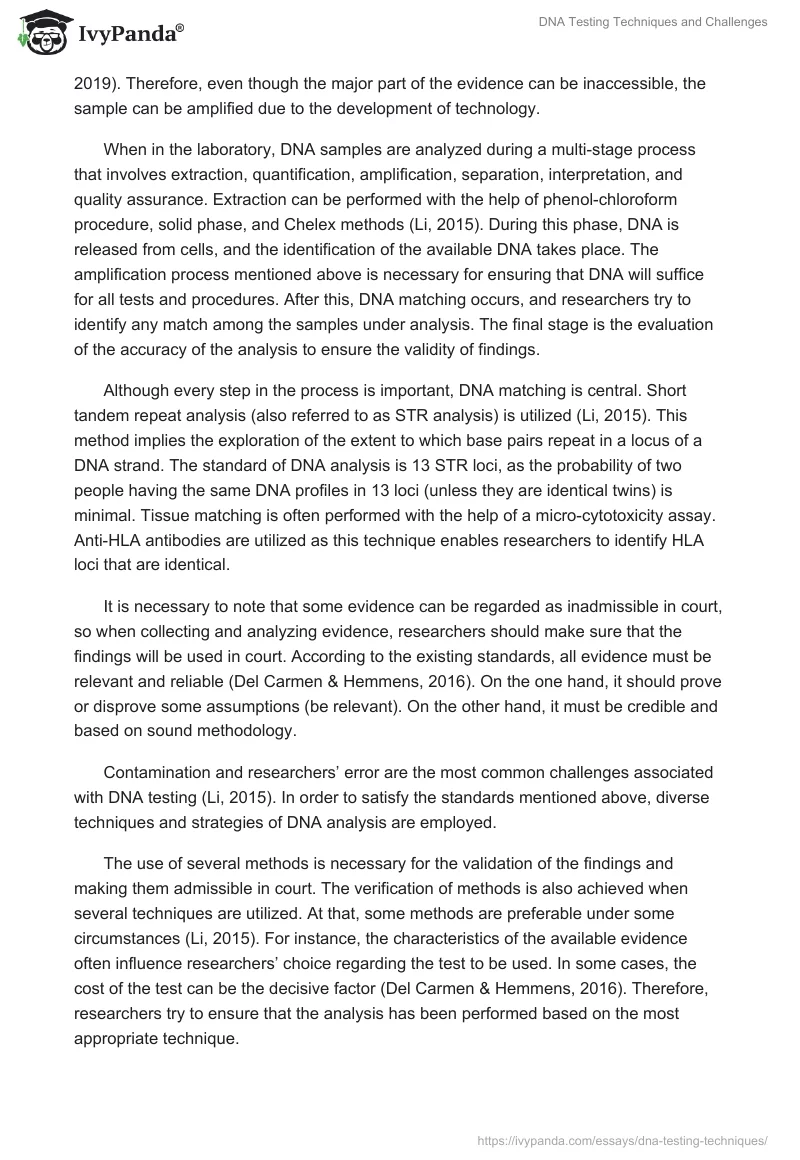Forensic science offers numerous opportunities that can help people in addressing various issues and arguments. DNA testing is one of the most common procedures that provides answers to numerous questions and sheds light on relevant details. This method of collecting evidence is often used to identify suspects (or, at least, some of their characteristics) or trace genetic links to solve family issues. This paper contains a brief description of several techniques employed in DNA testing and the challenges associated with this kind of analysis.
The admissibility of DNA test results in courts varies across states, and there is no single view on the matter in the country. At that, the advances in forensic science led to the increased use of such evidence and even the exoneration of people convicted years ago (Del Carmen & Hemmens, 2016). Prior to the extraction of DNA samples, it is necessary to obtain the corresponding permissions. The inmate should give their permission to use the data, and in some states, a court decision may be necessary. Depending on the details of the case, it is possible to use the convicted person’s blood or saliva to identify this person’s DNA.
As for the case materials, DNA samples can be received from clothes and items found at the crime scene. Clearly, these can be tissue, hair, saliva, or other biological samples that were analyzed during the court hearings (Bright & Coble, 2019). It can be possible to extract low-level DNA as some skin cells can be found on objects that were not analyzed previously due to the lack of technology-based instruments. These pieces of evidence should be stored for a certain period of time under appropriate circumstances (Del Carmen & Hemmens, 2016). Since ten years passed since the time the evidence had been stored, some materials can be lost (can disintegrate, rotten, or spoil).
Only a small amount of sample can be available due to natural factors. The polymerase chain reaction can be used to amplify the sample provided by the inmate, as well as existing materials related to the case for further investigation (Bright & Coble, 2019). Therefore, even though the major part of the evidence can be inaccessible, the sample can be amplified due to the development of technology.
When in the laboratory, DNA samples are analyzed during a multi-stage process that involves extraction, quantification, amplification, separation, interpretation, and quality assurance. Extraction can be performed with the help of phenol-chloroform procedure, solid phase, and Chelex methods (Li, 2015). During this phase, DNA is released from cells, and the identification of the available DNA takes place. The amplification process mentioned above is necessary for ensuring that DNA will suffice for all tests and procedures. After this, DNA matching occurs, and researchers try to identify any match among the samples under analysis. The final stage is the evaluation of the accuracy of the analysis to ensure the validity of findings.
Although every step in the process is important, DNA matching is central. Short tandem repeat analysis (also referred to as STR analysis) is utilized (Li, 2015). This method implies the exploration of the extent to which base pairs repeat in a locus of a DNA strand. The standard of DNA analysis is 13 STR loci, as the probability of two people having the same DNA profiles in 13 loci (unless they are identical twins) is minimal. Tissue matching is often performed with the help of a micro-cytotoxicity assay. Anti-HLA antibodies are utilized as this technique enables researchers to identify HLA loci that are identical.
It is necessary to note that some evidence can be regarded as inadmissible in court, so when collecting and analyzing evidence, researchers should make sure that the findings will be used in court. According to the existing standards, all evidence must be relevant and reliable (Del Carmen & Hemmens, 2016). On the one hand, it should prove or disprove some assumptions (be relevant). On the other hand, it must be credible and based on sound methodology.
Contamination and researchers’ error are the most common challenges associated with DNA testing (Li, 2015). In order to satisfy the standards mentioned above, diverse techniques and strategies of DNA analysis are employed.
The use of several methods is necessary for the validation of the findings and making them admissible in court. The verification of methods is also achieved when several techniques are utilized. At that, some methods are preferable under some circumstances (Li, 2015). For instance, the characteristics of the available evidence often influence researchers’ choice regarding the test to be used. In some cases, the cost of the test can be the decisive factor (Del Carmen & Hemmens, 2016). Therefore, researchers try to ensure that the analysis has been performed based on the most appropriate technique.
Apart from forensic research, DNA analysis is common in paternity testing. Prior to collecting the sample, the samplers provide their permission. The child, the father, and the mother (this is optional) provide their samples (saliva) for the test. During the collection process, the identity of the samplers is properly documented, and the photographs of the participants are taken (Rolf & Wiegand, 2016). The next step is the extraction of DNA, and certain STR loci are amplified. The researchers identify the maternal and paternal alleles if the mother takes part in the research. If maternal DNA is not available, more markers in the alleles are analyzed.
Paternity DNA tests are utilized in diverse cases that are closely related to familial law, but they can be used in criminal or immigration law as well. The test can be seen as a reliable piece of evidence in court due to the current methodology that is rather valid (Rolf & Wiegand, 2016). Paternity tests can be necessary to identify the relationship between people to decide whether a child has to receive financial aid from a particular man. Some countries require the implementation of the paternity test for the provision of a certain status to applicants.
In conclusion, it is noteworthy that DNA analysis has become a potent instrument in the legal systems of many countries. The uniqueness of people’s DNA makes it possible to identify the traces of certain people’s presence in particular places. Wrongful convictions can be minimized, and true criminals can be punished for their behavior. It is necessary to add that DNA testing is still associated with some challenges that are yet to be addressed.
For example, contamination and researchers’ error are still rather frequent, which leads to considerable problems. However, researchers continue developing new strategies and techniques that result in valid and reliable methodology. It is necessary to add that DNA analysis is also utilized in paternity tests that are common when solving familial or immigration issues.
References
Bright, J. A., & Coble, M. (2019). Forensic DNA profiling: A practical guide to assigning likelihood ratios. Boca Raton, FL: CRC Press.
Del Carmen, R. V., & Hemmens, C. (2016). Criminal procedure: Law and practice (10th ed.). Boston, MA: Cengage Learning.
Hall, J., Harger, K., & Stansel, D. (2015). Economic freedom and recidivism: Evidence from US States. International Advances in Economic Research, 21(2), 155-165. Web.
Janzer, C. (2019). North Dakota reforms its prisons, Norwegian style. U. S. News. Web.
Kirby, E. (2019). How Norway turns criminals into good neighbours. BBC. Web.
Labutta, E. (2017). The prisoner as one of us: Norwegian wisdom for American penal practice. Emory International Law Review, 31(2), 229-359.
Li, R. (2015). Forensic biology (2nd ed.). Boca Raton, FL: CRC Press.
Mpofu, E., Athanasou, J. A., Rafe, C., & Belshaw, S. H. (2018). Cognitive-behavioral therapy efficacy for reducing recidivism rates of moderate- and high-risk sexual offenders: A scoping systematic literature review. International Journal of Offender Therapy and Comparative Criminology, 62(1), 170-186. Web.
Piquero, A. R., Jennings, W. J., Diamond, B., & Reingle, J. M. (2015). A systematic review of age, sex, ethnicity, and race as predictors of violent recidivism. International Journal of Offender Therapy and Comparative Criminology, 59(1), 5-26. Web.
Rolf, B., & Wiegand, P. (2016). Paternity testing. In S. Bader (Ed.), A guide to forensic DNA profiling (pp. 159-166). Chichester, England: John Wiley & Sons.
Van Der Linden, S. (2015). Editorial: Green prison programmes, recidivism and mental health: A primer. Criminal Behaviour and Mental Health, 25(1), 338-342.


